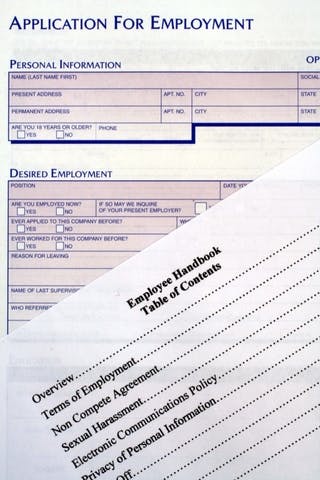You all know the drill: you’ve got a great candidate, you make the offer and now you’ve got to make sure they pass the background check.
Most of the time, it comes back with a green light and you’re good to go. Other times, there are discrepancies or other issues. The worst is when the discrepancies get revealed after the hire is made and you have to address the messy afterward of employee screening gone bad. And the bigger the position, the more important the background check. See: Every poorly vetted executive whose fake degrees or title inflation makes the news.
While there are horror stories, background check policies gone bad, and perhaps one or two panic inducing mix ups, knowing what is going on outside of your company can be a big help to plotting a proactive path to employee screening success.I had the opportunity to talk to Rob Pickell, VP, Customer Solutions at HireRight about the results of their annual employee screening benchmarking survey and some of the trends that they are seeing.
1. Employers are bullish on hiring
While not directly related to screening, it was a nice pick up from the benchmarking survey. Pickell said that 90 percent of employers weren’t planning on contracting this year while 43 percent said they planned on adding additional staff. This was a definitely a shift from 2009 and although far from exuberant, is definitely a positive.
2. A closer look at contingent/contract employee screening
Contingent and contract employee screening has always been a gray area. While companies often take an iron fist approach in dealing with regular employees they are hiring, they can be extremely passive about screening contract or contingent workforces. Hiring managers know this too as I had several who tried to get people who wouldn’t pass a background check on board using a contract or contingent agreement.
With the increase in the use of contracted/contingent staffing or independent contractors, this will only continue to grow as an issue to be resolved.
HireRight’s survey indicates that while over 90 percent of companies screened employees, only a little over a third screened contingent employees. While that number may be coming up, it is time to really analyze what you are getting from the contracting agency and how you want to protect yourself.
3. EEOC adverse impact decision as it relates to screening
We did get the opportunity to talk about the EEOC determinations about adverse impacts on minority applicants. While Pickell stressed that employers bear the ultimate responsibility, they do make a serious effort to inform and engage their clients about changes in the law.
As he mentioned in our conversation, it is in the employers best interest to screen all necessary but to only remove someone from the applicant pool if there is a business reason for removal. This falls in line with the EEOC guidelines, but isn’t always popular.
4. State-specific credit check rules
One of the major challenges of being a national screening company is keeping each individual state in line with their laws. If it is a pain to track legislation and court rulings for the federal code, it is doubly tough to keep track of 50 states and their independent actions.
A major one that has come to light recently has been the practice of banning credit checks in the hiring process (with some exemptions). Illinois joined three other states in generally banning the practice while a handful of other states are debating similar measures. Employers are choosing either to adapt to the strictest law on the books in the states they operate in or create custom programs for states with different standards than the federal.
Like before with the adverse impact ruing, Pickell advises clients to use credit checks to check only when necessary with the hopes of having a compliant policy no matter where they operate.
5. Social media screening looms
While not included in this benchmarking survey, Pickell states that they will start benchmarking the emergence of using social media to screen employees. They have heard that more employers are starting to use employee screening and would like to start tracking its popularity. Whenever I hear a number quoted in the news, it always seems to be a different number and standard, so it would be nice to get some clear year over year numbers related to social media screening.
Right now, the laws regarding social media employee screening are loose. While there are a few states with some legislation in committee, none of it looks to be getting traction anytime soon. This is an area where employer action could push the legislature or the courts to define the limits of what is and isn’t okay to use when looking at online profiles.
